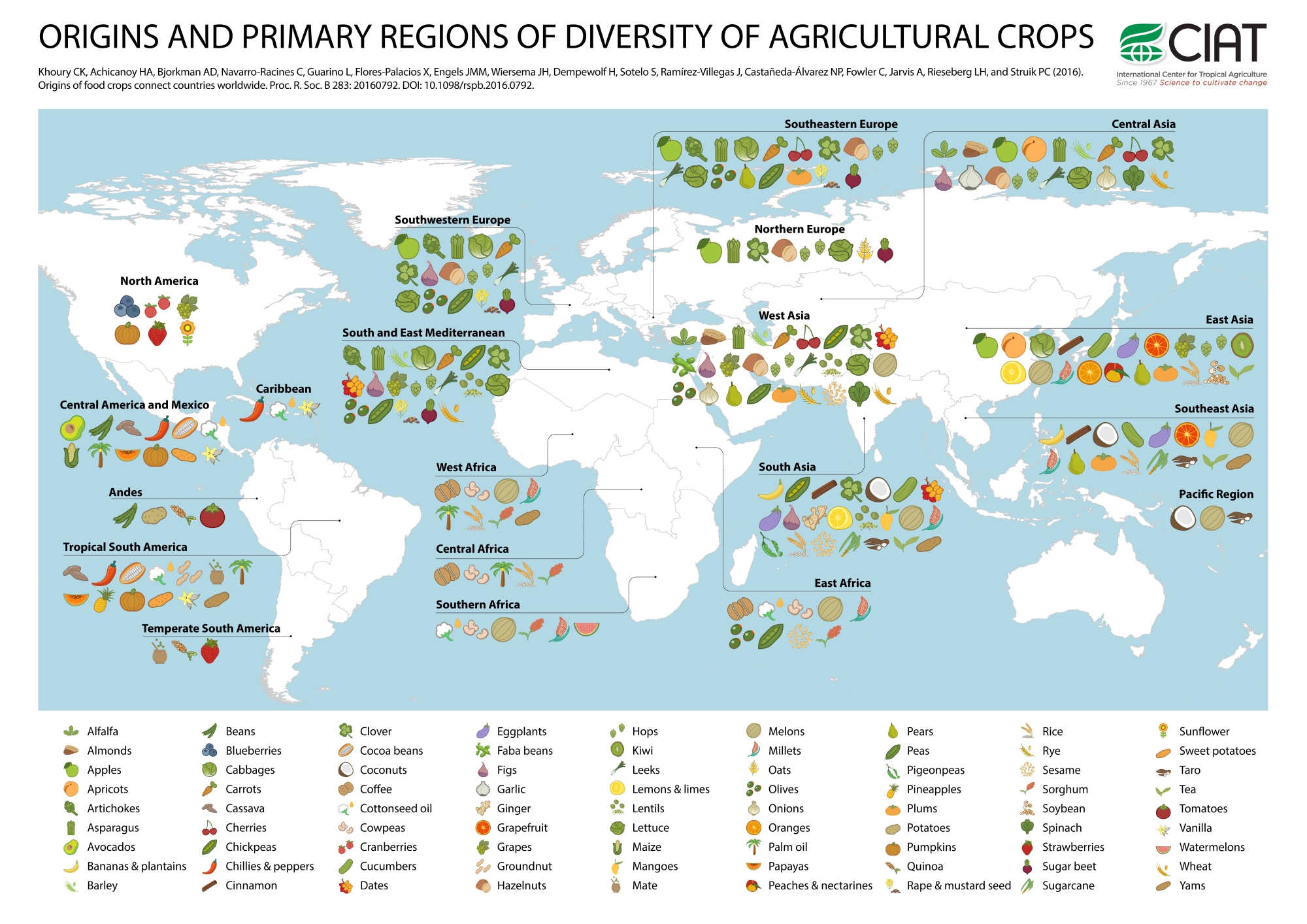Cool chart but definitely a little focused on western diets. Understandable given the intended audience but some of these regions that don’t show many crops have a rich diversity of domesticated plants that are in danger of being lost. The Andes in particular was a huge hotspot for plant domestication prior to colonization. Lost crops of the Incas is an interesting book on the topic if you want to learn more. Some of them could be important for the future of agriculture I think.
Solarpunk Farming
Farm all the things!
Also see:
Spare a thought for poor Australia. We're starving. Hawaii stole our Macadamias and they aren't giving them back.
Well when you only have the one you leave yourself open to that! You guys need to get some plant domestication programs going.
I guess Eucalyptus might count as a crop by some definitions though not for food.
True, but I think one of the oldest continuous cultures on Earth may take exception to that statement! There are plenty of native foods here but defining them as an agricultural crop is difficult after relatively modern colonialism did a number on the country.
Here is an example of a staple being basically wiped out thanks to traditional agriculture - https://tuckerbush.com.au/murnong-yam-daisy-microseris-lanceolata/
Interesting plant, I’m unfamiliar with it. Was it cultivated to the extent that it could be called a crop?
Sometimes this can be a tough question to answer. In California the native people had a form of horticulture that was unrecognizable to colonists until these “wild” food sources began to disappear and anthropologists earned enough trust that they were educated on the traditional techniques. But are these plants domesticated or wild? Or something in between?
You indicated we needed to get to work domesticating crops so we could contribute to the map. I floated the idea that the reason why domestication is hard is that the country has suffered rapid colonisation with, in some areas, up to 98% of forest being cleared so fast that nothing could keep up. With a "hunter gatherer" society utilising a nomadic system of resource control, there was no need for modern domestication; they found a balance in population vs wild resource (which, with hindsight, most places should have done instead - we would have a liveable planet). They moved plants about, managed edible resources with common ag techniques like fire, had food-related festivals which you know about (I linked you a document) etc.
Similar to the American First Nations, yes. Except Australia rather than from the 1600's where there was 200 years of adjustment before hyper-rapid vegetation changes were made, they just were "modernised" (culturally genocided?) in a blink of an eye. All that knowledge was near lost almost instantly. For example, each area had a particular way of making storage bags (dilly bags) and there remain some examples and some knowledge of how it was done (and continues to be). In our area that knowledge is completely lost; no one knows how to make our local style. If you lose the ability to make a cultural item that rapidly, imagine what happened to the plants.
While Macadamias are the only really well known native crop to come out of Australia (before being taken by Cook to Hawaii) there's recently been a push to rediscover a lot of the crops originally cultivated by the first people of Australia. These include Finger Limes, Bush Tomato, Kangaroo Apples, Lilly Pilly, Atherton Raspberries, Murnong and excitingly mamadyang ngalluk or "dancing grass".
Nearly missed this reply. Tag me next time. I, not as well as you, basically replied something similar.
You can add Bunya to the list? That's gaining a resurgence before Phytophthora gets them in their native range.
I think we talked about that one in another thread but it’s one of my favorite trees. I’m trying to popularize them here in California but our ideas about liability are not entirely compatible with the hazard presented by the cones so it’s hard to find someone who will grow them. I harvested many last year and greatly enjoyed them.
Do they have issues with phytophthora? I have not seen that here though it’s not a common tree.
There is no risk when it's managed. The indigenous climbed the trees before they fell, knocked one off to check, and then manually harvested. This is in that document.
The risk comes from urban trees being unmanaged in high risk areas. If you had a fenced off plot of Bunya, minimal risk.
Yes, there is a disease attacking Bunya in their original native range, Bunya Mountains and the Blackall Range. It's early days but there is a risk that a lot of trees will be lost in certain areas.
Tragic. I’ve never seen one look sick around here so I assume that strain/species is not present here yet. Hope it never arrives.
Check if you have it (websearch the species):
Looks like we do. But then I wonder why we don’t experience the same problems as in its native range?
California drier than the rainforest they are present in here? Allows greater movement?
It's so early, not enough research done. If it starts affecting Hoop badly, which is a forestry timber, then more money will be thrown at it maybe.
Always a nice factoid, the tallest Bunya in the world is in Portugal. Hopefully it will stay safe there!
https://www.atlasobscura.com/places/tallest-tree-in-europe-portugal
Definitely drier here, we get less than half the rainfall of those forests. But people also irrigate a lot and the clay soil means it can be pretty soggy at times.
If it still exists this says there is a taller one in Australia: https://www.conifers.org/ar/Araucaria_bidwillii.php
